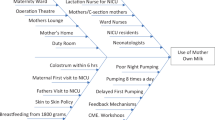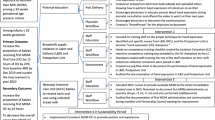Abstract
Objective:
Mothers of neonatal intensive care unit (NICU) patients sometimes bring expressed milk that is blood tinged to the NICU. In certain instances, the blood contamination appears minimal, whereas in others, the milk is quite dark pink. We have observed inconsistencies in practice regarding whether or not to feed blood-tinged colostrum or milk to NICU patients. We know of no evidence that establishes best practice in this area, and thus we sought to determine attitudes of NICU professionals on which to base a potentially best practice.
Study Design:
We conducted a web-based anonymous survey of attitudes of NICU professionals at Intermountain Healthcare regarding feeding blood-tinged expressed milk to NICU patients. These professionals included neonatologists, neonatal nurse practitioners, NICU nurses, NICU dieticians and lactation consultants.
Result:
Survey results were returned from 64% (426 of 667) of those to whom it was sent. A total of 75% of respondents reported that their practice was NOT to feed the blood-tinged milk illustrated in the figure as sample 2, and nearly all respondents (98%) reported that they would NOT feed the milk illustrated as sample 3. The majority of the neonatologists (56%) and the lactation consultants (58%) recommended feeding moderately bloody milk (sample 2), whereas only 22% of the neonatal nurse practitioners (NNPs), NICU nurses and NICU dieticians recommended feeding such samples (<0.001). The most frequently selected reason for NOT feeding blood-tinged milk was that it would likely cause gastrointestinal upset and feeding intolerance (selected by 77%). The majority (87%) overestimated the amount of blood contaminating a milk sample (sample 3).
Conclusion:
As colostrum and human milk feedings can be of value to NICU patients, evidence should be assembled to document whether feeding blood-tinged samples indeed have the problems listed by the survey respondents. Such evidence is needed to enable informed decisions involving the benefits vs risks of feeding blood-tinged expressed milk to NICU patients.
This is a preview of subscription content, access via your institution
Access options
Subscribe to this journal
Receive 12 print issues and online access
$259.00 per year
only $21.58 per issue
Buy this article
- Purchase on Springer Link
- Instant access to full article PDF
Prices may be subject to local taxes which are calculated during checkout

Similar content being viewed by others

References
Pediatrics AAP, Policy Statement. Breastfeeding and the use of human milk. Pediatrics 2005; 115: 496–506.
Schanler RJ, Lau C, Hurst NM, Smith EO . Randomized trial of donor human milk versus preterm formula as substitutes for mothers' own milk in the feeding of extremely premature infants. Pediatrics 2005; 116: 400–406.
Meier PP, Engstrom JL, Mingolelli SS, Miracle DJ, Kiesling S . The Rush mother's milk club: breastfeeding interventions for mothers with very-low-birth-weight infants. J Obstet Gynecol Neonatal Nurs 2004; 33: 164–174.
Howie PW, Forsyth JS, Ogston SA, Clark A, Florey CD . Protective effect of breast-feeding against infection. BMJ 1990; 300: 11–16.
Palta H, Mansback I, Pridan H, Adler B, Palta Z . Episodes of illness in breast-fed and bottle-fed infants in Jerusalem. Isr M Med Sci 1984; 20: 395–399.
Edmond KM, Zandoh C, Quigley MA, Amenga-Etego S, Owusu-Agyei S, Kirkwood BR . Delayed breast-feeding initiation increases risk of neonatal mortality. Pediatrics 2006; 117: e380–e386.
Lambert DK, Christensen RD, Henry E, Besner GE, Baer VL, Wiedmeier SE et al. Necrotizing entercolitis in term neonates: data from a multihospital healthcare system. J Perinatol 2007; 27: 437–443.
Updegrove K . Necrotizing enterocolitis: the evidence for use of human milk in prevention and treatment. J Hum Lact 2004; 20: 335–339.
Street JL, Montgomery D, Alder SC, Lambert DK, Gerstmann DR, Christensen RD . Implementing feeding guidelines for NICU patients <2000 g results in less variability in nutritional outcomes. JPEN 2006; 30: 515–518.
Montgomery D, Schmutz N, Baer VL, Rogerson R, Wheeler R, Rowley A-M et al. Effects of instituting the ‘B.E.S.T. Program’ (Breastmilk Early Saves Trouble) in a level III NICU. J Hum Lact 2008; 24: 248–251.
Stout G, Lambert DK, Baer VL, Gordon PV, Henry E, Wiedmeier SE et al. Necrotizing enterocolitis during the first week of life: a multicenter case-control and cohort comparison study. J Perinatol 2008; 28: 556–560; doi:10.1038/jp.200.
Ip S, Chung M, Raman G, Chew P, Magula N, DeVine D et al. Breastfeeding and Maternal and Infant Health Outcomes in Developed Countries. Evidence Report/TechnologyAssessment No. 153. AHRQ Publication No. 07-E007. Agency for Healthcare Research and Quality: Rockville, MD, 2007, p 1–186.
Patel AL, Meier PP, Engstrom JL . The evidence for use of human milk in very low-birth weight preterm infants. NeoReviews 2007; 8: e459–e466.
Virdi VS, Jatinder S, Goraya JS, Alka Khadwal A . Letter to the Editor. Indian Pediatr 2001; 38: 931–932.
http://parenting.ivillage.com/baby/bbreastfeed/0,3x3g,00.html.
Kline TS, Lash SR . The bleeding nipple of pregnancy and postpartum period: a cytologic and histologic study. Acta Cytol 1964; 8: 336–340.
Lafreniere R . Bloody nipple discharge during pregnancy: a rationale for conservative treatment. J Surg Oncol 1990; 43: 228–230.
Lawrence RA, Lawrence RM . Breastfeeding: A Guide for the Medical Profession, 5th edn. Mosby: St Louis, 1999 pp 737–739.
Chirico G, Marzollo R, Cortinovis S, Fonte C, Gasparoni A . Anti-infective properties of human milk. J Nutr 2008; 138: 1801S–1806S.
Garel M, Dardennes M, Blondel B . Mothers' psychological distress 1 year after very preterm childbirth. Results of the EPIPAGE qualitative study. Child Care Health Dev 2007; 33: 137–143.
Tang FI, Sheu SJ, Yu S, Wei IL, Chen CH . Nurses relate the contributing factors involved in medication errors. J Clin Nurs 2007; 16: 447–457.
Rochette A, Korner-Bitensky N, Desrosiers J . Actual vs best practice for families post-stroke according to three rehabilitation disciplines. J Rehabil Med 2007; 39: 513–519.
Acknowledgements
We thank the neonatologists, neonatal nurse practitioners, NICU nursing staff, lactation specialists and dietary staff at the Intermountain Healthcare NICUs for their assistance in completing the survey.
Author information
Authors and Affiliations
Corresponding author
Rights and permissions
About this article
Cite this article
Phelps, M., Bedard, W., Henry, E. et al. Attitudes of NICU professionals regarding feeding blood-tinged colostrum or milk. J Perinatol 29, 119–123 (2009). https://doi.org/10.1038/jp.2008.188
Received:
Revised:
Accepted:
Published:
Issue Date:
DOI: https://doi.org/10.1038/jp.2008.188
Keywords
This article is cited by
-
More on professionals’ attitudes on blood-tinged milk: a survey from Italy
Journal of Perinatology (2012)
-
Feeding blood-tinged expressed mother's milk in the NICU
Journal of Perinatology (2010)


